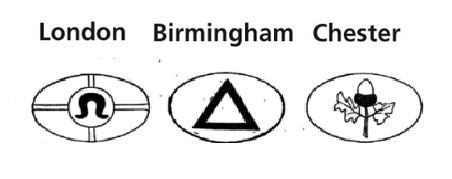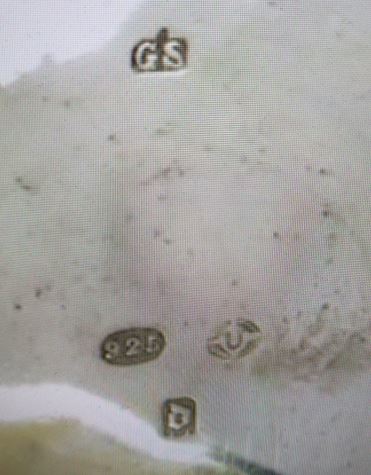Last updated on April 27, 2024
If you were to start collecting Swiss made pocket watches from the early 20th century inevitably, you will come across the name George Stockwell. His sponsor’s mark appears on thousands of Swiss watch cases imported into Britain. The watches are often erroneously described as George Stockwell watches. However, this is most certainly not the case. George Stockwell never made a watch or a watch case in his entire life. He, or at least his company, were importers, agents and sponsors in the assaying process for British hallmarks. The following legal Acts are those that should have applied to imported precious metal watch cases since at least 1842.
1842 Customs Act
The British 1842 Customs Act was a law passed by the British government that established a new system of customs duties on imported goods. The act replaced the old system of customs duties that had been in place since the 17th century. Under the new system, customs duties were based on the value of the goods being imported rather than their weight or volume. Section 59 of the act was concerned with precious metals. There were new customs duties on imported gold and silver.
Under the act, gold and silver were subject to a duty of 1 shilling per ounce if they were imported in the form of bullion or coin. If they were imported in the form of jewellery or other manufactured goods, they were subject to a duty of 5% ad valorem (based on the value of the goods). The act also established a new system of bonded warehouses where imported gold and silver could be stored without paying customs duties until they were sold.
1883 Revenue Act
The 1883 Revenue Act, section 10, stated that all gold or silver imported into Great Britain should be deposited in a bonded warehouse and not released from bond until it had been hallmarked. The marks remained the standard British hallmarks and the letter “F”, for Foreign. Watch cases seemed to have been excluded from this practice, until a later act of parliament in 1887.
British Merchandise Marks Act of 1887
Parliament introduced the British Merchandise Marks Act of 1887. This was enacted to force foreign manufacturers to mark their goods with the country of origin. This was put in place to protect British industries from foreign suppliers sending low-quality goods and promoting them as locally made. Watch cases were now in the spotlight and were required to be assayed and hallmarked. The standard British hallmarks were meant to be used, plus the foreign mark.
All of the above acts should have been applied to imported watch cases made of gold or silver. However, for some unknown reason, British customs ignored these laws when it came to imported watch cases. I have not been able to find a clear explanation as to why. Certainly, foreign manufacturers were happy with the oversight as they bypassed the expense and inconvenience of having their cases assay. I am not sure why the British watchmakers did not complain about the oversight. Foreign manufacturers avoided the cost of assaying and would have been able to undercut the local makers.
Assay of Imported Watch-Cases Act, 1907
All of this changed following the passing of the Assay of Imported Watch Case Act on the 1st of June 1907. The following was read out by the Earl of Granard in the House of Lords on the 15th of July 1907:
“My Lords, the necessity for this Bill has been brought about in a rather curious way. According to the Customs Act, 1842, all foreign plate imported into this country must be of the same standard as our own plate and must be hall-marked. For some reason the customs authorities have always considered that watch cases did not come within the meaning of the Act, and consequently up to the present time they have always been exempted from assay and marking.
The result is that watch cases of all kinds have been brought into this country, and cases have been sold as gold and silver which were nothing of the sort. The Court of Appeal the other day ruled that watch cases were plate within the meaning of the Act, and the object of this Bill is to exempt from assay and hall-marking all watch cases which are at present in stock over here and which came into this country before 1st June last.”
This meant that all watch cases imported before the 1st of June 1907 were exempt from assay, but all cases after that date had to be assayed and hallmarked. Each assay office had a specific mark for imported goods. The Date and Purity markings remained the same as that for British goods.
Assaying process
Because of the nature of assaying, the watch cases would have needed to be sent before they were fully finished. The assay office was certainly not interested in removing the movement from a case, as this would mean using skilled watchmakers in the process. They just wanted to assay the case material, therefore the case manufacturer needed to send the case only.
The assaying required a scraping to be taken from the case to verify the purity of the gold or silver. This meant a scratch that would later need to be polished out. The indents from the hallmarks would have also caused minor damage to the case, which again would require work. Therefore, a Swiss watch case manufacturer would need to pay for the delivery of the case to the UK, the cost of the assay process and the cost of the return of the case to Switzerland for final polishing. It is no wonder that the foreign watch case manufacturers adhered to the British custom’s official ignorance of the rules.
The enforcement of the hallmarking regulations created obstacles for the Swiss watchcase makers. Some of the larger Swiss manufacturers already had established premises in Britain and these were able to manage the hallmarking process. However, many of the smaller Swiss manufacturers only had sales agents and did not have premises in Britain. This created an opportunity for British firms such as Stockwell & Company to act as assay agents. Other British firms acting as assay agents included Dimier Brothers & Company and Robert Pringle & Sons.
Stockwell & Company
Stockwell & Company was founded in 1878 by Henry Stockwell. In 1900 was incorporated as a limited liability company Stockwell & Co. Ltd. The company operated out of its head office at 16 & 18 Finsbury Street, London, however, they did expand to many depots around the UK. The company acted as the sole agents of Messageries Nationales in Britain. Messageries nationales was a French shipping company, originally founded in 1851. It operated routes primarily to the Middle and Far East, including the Mediterranean, Black Sea, Red Sea, Indian Ocean and China Sea. It later expanded to include the Pacific and South Atlantic. Messageries Nationales was a major player in the French merchant shipping industry for over 150 years. The company’s ships carried a wide variety of cargo, including mail, passengers, and freight.
When the Assay of Imported Watch Case Act came into force on the 1st of June 1907, Stockwell & Company seized the opportunity. At the time the company was managed by George Stockwell, the nephew of the founder. George registered sponsors marks with several British assay offices including, London, Birmingham and Glasgow. Stockwell was able to leverage the Messageries Nationales shipping network using the Messageries agent in Switzerland.
Hallmarking
Swiss manufacturers would ship the unfinished watch cases to Britain. Stockwell & Company would deposit a bond with the customs authorities and transport the package to an assay office. The hallmarking would then be completed, at which point, Stockwell’s would return them to Switzerland and reclaim the bond. The Swiss manufacturer would then repair the damage from the hallmarking process and polish the case. The watch case would then be ready to be fitted with a movement. The completed watch would then be sent back to Britain, ready for sale.
In the 1930s Stockwell & Company merged with another international carrier – Hernu, Peron & Co. This combined company bore the name Hernu, Peron & Stockwell Ltd and continued business until 1990. According to Companies House, Hernu, Peron & Stockwell Ltd changed its name to Compass Travel Limited on the 19th of January 1990. The company was ultimately dissolved on the 24th of February 2016.
Note: I also found references to George Stockwell & Co Ltd during my research. However, I cannot find a reference at Companies House. It is referenced by the British Museum.
Related content
Stockwell & Company at Vintage Watchstraps.


Very informative, I always assumed the “Sponsor’s mark” belonged to the case maker. I stand corrected!
Hi Nick, don’t worry, you aren’t the only one to fall for that trap. There are many people out there, including long term sellers, who refer to the Sponsor as the actual watchmaker. Thanks for taking the time to comment, Jason